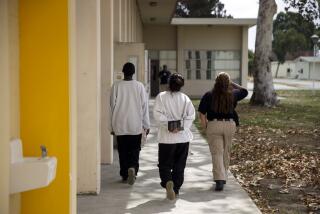Prison overcrowding negotiations get 30 more days
- Share via
SAN FRANCISCO -- — Three federal judges agreed Friday to give the state an additional 30 days to reach an accord to reduce overcrowding in state prisons and avoid a trial that could lead to a mass release of convicted criminals.
But the judges announced that if no settlement is reached, they will begin a trial in November to determine whether overcrowding is the primary cause of unconstitutionally poor medical and mental health care in state lockups.
The extension came after the state and other parties to the federal court case reported that they had failed after months of negotiations to meet a Friday deadline for settling the case. Yet they requested more time.
“The state believes that we need more information before we can commit to a settlement,” Andrea Lynn Hoch, Gov. Arnold Schwarzenegger’s legal affairs secretary, told the judges.
The state and its opponents had been considering a deal that would have diverted low-risk parole violators and some newly convicted criminals to community-based treatment programs, county jails and alternative methods of incarceration.
During the next 30 days, the state and inmates’ lawyers said, they will form a committee to determine the appropriate population level for the state prisons. Hoch said the state also wants to study how much it would cost to pay for treatment programs.
But inmates’ lawyers said they could not wait long. Donald Specter, director of the nonprofit Prison Law Office, reminded the judges that the state had long missed deadlines to make progress in fixing the problems. “We have been what I think could be generously described as extraordinarily patient,” he said.
Michael Bien, another lawyer for prisoners, said the state’s proposed new prison beds and medical facilities are “years away,” while inmates are still “suffering and dying unnecessarily.”
The three-judge panel is composed of U.S. District Judges Thelton Henderson and Lawrence Karlton and U.S. 9th Circuit Court of Appeals Judge Stephen Reinhardt, who participated via closed circuit television from Los Angeles.
The judges said they were mindful of the need to improve care quickly by going to trial. The conditions in the prisons “are not only unconstitutional, they are unconscionable,” Karlton said.
But he said an amicable settlement would be better because it could factor in the political considerations needed for a workable solution.
“It’s trying to balance these two objectives that we are faced with today,” Karlton said.
The judges indicated that they would also make public the settlement proposal crafted by two mediators, which has been kept confidential, so other interested groups who are not officially connected to the case, such as Democratic lawmakers, can get involved.
But there appeared to be a deep divide separating lawyers for inmates and others involved with the case. Specter said they had been unable to agree on a population level for prisons.
A recent settlement draft proposed a target population of 132,000, a reduction of 39,000 from the 171,000 inmates in state prisons today. (The prisons were designed to hold fewer than 100,000.)
But Specter said that number was not agreed upon. And while inmates’ lawyers insist the prison population must be reduced, Specter said a major obstacle is that some local officials have opposed many methods of accomplishing that through changes to the penal or parole system.
Assemblyman Todd Spitzer (R-Orange), who represented Republican lawmakers in the case, said his colleagues oppose the proposal to divert inmates to community programs and county jails, and he suggested waiting to see if construction of new prisons and medical beds would relieve overcrowding. But inmates’ lawyers have said that won’t work. Still, Spitzer said he wanted to keep negotiating.
“I will honestly submit to you that we have made more progress than I ever would have imagined,” he said.
--
More to Read
Sign up for Essential California
The most important California stories and recommendations in your inbox every morning.
You may occasionally receive promotional content from the Los Angeles Times.










